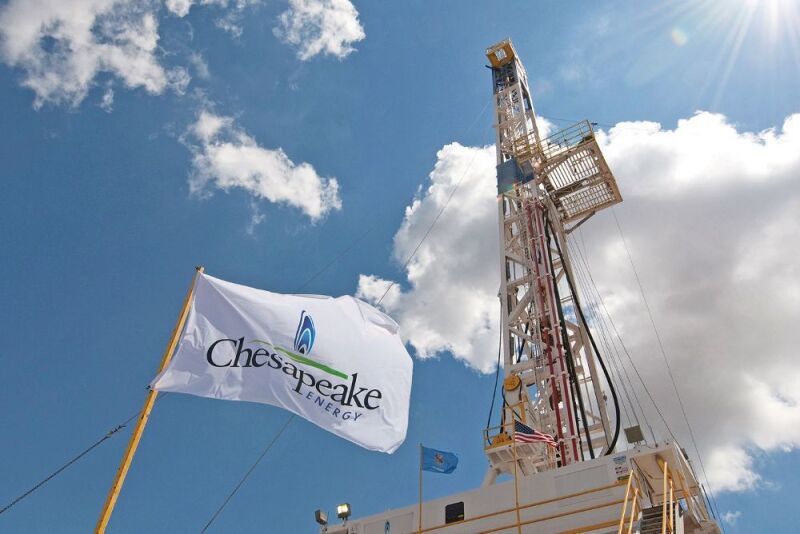Oklahoma City-based Chesapeake Energy has made the first big US shale deal of the year with the estimated $2.5-billion acquisition of privately held Chief E&D Holdings LP and nonoperated assets owned by Tug Hill Inc. The transaction will bolster Chesapeake’s position in the gas-rich Marcellus Shale in Pennsylvania.
Terms include a $2-billion cash payment and about 9.44 million of Chesapeake’s common shares. For this sum, Chesapeake is set to own Chief’s 113,000 net acreage position which will raise the buyer’s total holdings in the gas play to around 653,000 net acres. Also, Chesapeake said it is adding 500 undeveloped drilling locations, giving it a combined runaway that equates to about 1,500 yet-to-be-drilled wells in the Marcellus.
Speaking with investors on a conference call about the deal, Chesapeake CEO Nick Dell’Osso said the pro forma inventory in the Marcellus includes just over 500 “premium locations” which are defined as having a 50% rate of return at $2.50 NYMEX gas price.
While presenting an acreage map of the combined lease locations, Dell’Osso emphasized that “probably the most exciting part of the deal” involves having greater access to transportation networks for its sales gas.
“The map really highlights that the Chesapeake and Chief acreage fit hand in glove, right next to each other,” he said, adding that the two firms share gathering line capacity which will increase delivery points.
“What that means is that we have access to better out-of-basin pricing, and we can manage our production and our pressure across the systems better to open up incremental capacity on a combined basis that really wasn’t available individually.”

Chesapeake expects access to more pipelines will enable an incremental increase in production of 200 MMscf/D.
On a pro forma basis, the company said average gas production will swell from about 1.2 Bcf/D to more than 2 Bcf/D. Additionally, Chesapeake is projecting a pro forma free cash flow of more than $1.4 billion for 2022 and notes that the 5-year free cash flow estimate for the acquired position amounts to more than $1.5 billion.
Another driver for the deal involves Chesapeake’s pledge to become a net-zero emitter of greenhouse gas by 2035.
By year end, the operator said it will have 100% of the combined gas operations in the Marcellus certified as “responsibly sourced gas,” which involves using independent third parties to verify that the production has met certain ESG, or environmental, social, and governance, standards. As a result, Chesapeake projects its methane intensity will drop by 15% as compared with its last reported emissions figures from 2020.
While making a push into the Marcellus, Chesapeake will exit its 190,0000-acre position in Wyoming’s Powder River Basin. As part of a separate deal, Chesapeake said Oklahoma City-based Continental Resources has agreed to take over its Powder River holdings for around $450 million. This marks Continental's third acquisition in the Powder River basin since March of 2021.
After shedding its Wyoming holdings, Dell’Osso said Chesapeake will be focused on its “three greatest assets” which are the newly expanded Marcellus development along with 220,000 net acres in the Eagle Ford Shale of south Texas and its 348,000 net acres in the Haynesville Shale of northern Louisiana.
The Chief acquisition includes taking on debt, and including proceeds from the Powder River divestment, Chesapeake said the result will increase its debt load from $1.3 billion to around $2.9 billion.
"We had highlighted coming out of bankruptcy that we wanted to refocus our portfolio and we've achieved that here," said Dell'Osso, referencing the new business plan that was adopted after it exited the Chapter 11 bankruptcy process last year, eliminating almost $7.8 billion in debt.
Chesapeake also operates in the Brazos Valley region of central Texas. The company has been speculated to be seeking buyers for its position there, inclusive of some 420,000 net acres, since at least 2019.
The Brazos Valley asset was not mentioned as “core” to the company’s future during the call with investors. When pressed on its future by one investor, Dell’Osso said there is a “fair amount of confidence” in the Brazos Valley operations after Chesapeake moved to wider well spacing.
“We will always maintain the notion that if an asset isn’t performing, we can think differently about it,” he said, and adding, “But right now we’re very comfortable with what we’re doing in the Brazos.”
Chesapeake’s latest purchase agreement follows a $2.2-billion acquisition of Vine Energy and its holdings in the Haynesville Shale in northern Louisiana. That deal, which closed in November, was said to make Chesapeake the largest gas producer in the Haynesville with a projected average output of 1.6 Bcf/D.
Chesapeake said its latest acquisition and divestment deals are expected to close by the end of this quarter.


